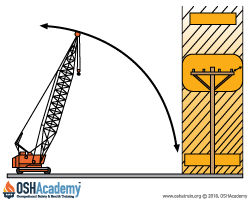Establishing Work Zones
Keeping a safe distance from power lines is the key to preventing power line accidents.
The first step is to identify the work zone. There are two ways to identify the work zone:
- Set Boundaries: Demarcating boundaries (such as with flags, or a device such as a range limit device or range control warning device) and prohibiting the operator from operating the equipment past those boundaries, or
- Define work zone: Defining the work zone as the area 360 degrees around the equipment, up to the equipment's maximum working radius.
Next, determine if any part of the equipment, load line or load (including rigging and lifting accessories), if operated up to the equipment's maximum working radius in the work zone, could get closer than 20 feet to a power line. If so, you must meet the requirements in one of the three options below:
- Deenergize and ground. Confirm from the utility owner/operator that the power line has been deenergized and visibly grounded at the worksite.
- 20 foot clearance. Ensure that no part of the equipment, load line, or load (including rigging and lifting accessories), gets closer than 20 feet to the power line by implementing the measures specified above.
- Alternative clearance. Determine the line's voltage and the minimum approach distance permitted under OSHA 1926.1408, Table A, below.
Table A - Minimum Clearance Distances
|
Voltage (nominal, kV, alternating current) |
Minimum Clearance Distance (feet) |
|---|---|
| up to 50 | 10 |
| More than 50 - 200 | 15 |
| More than 200 - 350 | 20 |
| More than 350 - 500 | 25 |
| More than 500 - 750 | 35 |
| More than 750 - 1,000 | 45 |
| More than 1,000 | established by the utility owner and/or operator or registered professional engineer who is a qualified person |
Note: The value that follows "to" is up to and includes the value. For example, more than 50 to 200 means up to and including 200 kV.
Source: www.osha.gov
Knowledge Check Choose the best answer for the question.
4-2. What is the first step you must take before operating a crane on a site where a power line is present?
You forgot to answer the question!

